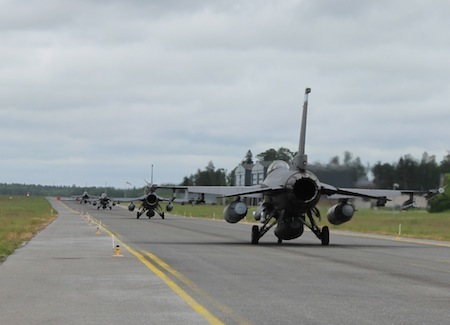 Tallinn, Estonia— The Estonian air force operates just four helicopters, two small transport airplanes, and is leasing two L-39 jets meant for training the country’s 12 joint terminal air controllers as well as the fighter controllers who do ground control intercepts for NATO’s air policing mission. However, Estonian air force Commander Col. Jaak Tarien said he hopes a continuous allied presence at Amari Air Base will “deter anybody from attacking Estonia.” Though small, the airfield is extremely modern and can accommodate all types of NATO aircraft, said Tarien in a June 13 interview at Amari. The “key to airpower is flexibility [and] this airfield is available, maintained, manned with trained people, and equipped with high-quality modern equipment. We gladly host allied training and deployments here,” he said. The biggest challenge is that parking space is limited. As of now, there is room for just one squadron of 12 to 14 fighters, and the cargo apron can hold four C-17s. There are two KC-135s, one from the Pennsylvania ANG and one from Michigan’s Air Guard, parked there during NATO’s Saber Strike exercise, which runs through June 20. The other side of the runway is empty, except for a row of old Soviet bunkers, allowing for expansion in the future, if necessary, said Tarien. “It’s the best airfield of all the Baltic states, due to the [runway’s length] and the infrastructure needed to house people,” said Capt. Brian Radford, commander of the Pennsylvania Air National Guard’s 171st Air Refueling Wing detachment.
Tallinn, Estonia— The Estonian air force operates just four helicopters, two small transport airplanes, and is leasing two L-39 jets meant for training the country’s 12 joint terminal air controllers as well as the fighter controllers who do ground control intercepts for NATO’s air policing mission. However, Estonian air force Commander Col. Jaak Tarien said he hopes a continuous allied presence at Amari Air Base will “deter anybody from attacking Estonia.” Though small, the airfield is extremely modern and can accommodate all types of NATO aircraft, said Tarien in a June 13 interview at Amari. The “key to airpower is flexibility [and] this airfield is available, maintained, manned with trained people, and equipped with high-quality modern equipment. We gladly host allied training and deployments here,” he said. The biggest challenge is that parking space is limited. As of now, there is room for just one squadron of 12 to 14 fighters, and the cargo apron can hold four C-17s. There are two KC-135s, one from the Pennsylvania ANG and one from Michigan’s Air Guard, parked there during NATO’s Saber Strike exercise, which runs through June 20. The other side of the runway is empty, except for a row of old Soviet bunkers, allowing for expansion in the future, if necessary, said Tarien. “It’s the best airfield of all the Baltic states, due to the [runway’s length] and the infrastructure needed to house people,” said Capt. Brian Radford, commander of the Pennsylvania Air National Guard’s 171st Air Refueling Wing detachment.
Air Force Gen. Alexus G. Grynkewich assumed command of U.S. European Command on July 1, taking over the key assignment as the U.S. and its allies contend with a resurgent Russia and a grinding war in Ukraine.
